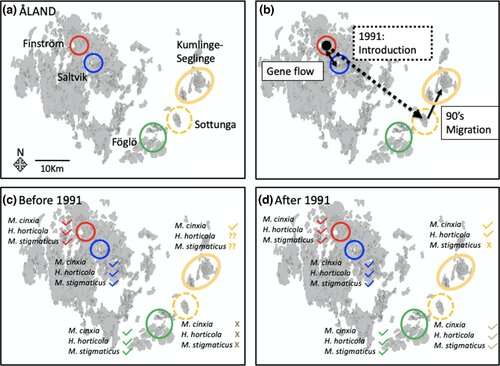One insect species introduced decades ago to a small island had an effect on several insect populations

Larvae of the Glanville fritillary butterfly, Melitaea cinxia, were introduced to the island of Sottunga in the Åland Islands, Finland, in 1991. The original research project for which this introduction was aimed failed. However, although the island was previously free of the butterfly, the relocated species persisted, offering the ground for investigating how an entire insect community could be affected by one introduction event.
"What the researchers did not know 30 years ago was that the larvae carried along with them the butterfly parasitoid wasp Hyposoter horticola. The parasitoid then carried its hyperparasitoid wasp Mesochorus stigmaticus, and a mum-to-offspring transmitted bacterial symbiont Wolbachia pipientis that somehow increases the susceptibility of the host H. horticola to M. stigmaticus," says academy research fellow at the University of Helsinki, Dr. Anne Duplouy.
Thanks to yearly survey of the Åland butterfly population, researchers from the University of Helsinki and the Cornell University, U.S., have shown that the butterfly population introduced to Sottunga has faced several bottlenecks since 1991. It consequently is genetically quite diminished and faces a high risk of extinction.
"If local butterfly populations are small and unstable their parasitoids must be mobile enough to find hosts elsewhere. We have been able to show that the parasitoid H. horticola is dispersive in Åland. Furthermore, it has persisted and shows less genetic structure than the butterfly host. This probably explains their genetic mixing with populations on a nearby island after introduction to Sottunga. Introduced genotypes have potentially kept nearby populations from extinction during host population declines," Anne Duplouy says.
The hyperparasitoid M. stigmaticus isn't quite as mobile and has a smaller population size, so it suffers from inbreeding and is absent from some islands. Where the hyperparasitoid is absent, the parasitoid lineages with Wolbachia can flourish.
"The genetic signature of introduced wasp lineages gives us a window into what has happened in an island archipelago over the 25 years since their accidental introduction, including persistence through population bottlenecks, dispersal and interbreeding, as well as sorting among lineages depending on a hyperparasitoid and bacterial symbiont," says Dr. Saskya van Nouhuys from Cornell University, U.S., who has studied the parasitoid populations in Åland since 1998.
The researchers are excited to see how genetic methods can complement ecological studies and be useful in studying and making inferences about a population introduced decades ago.
"We have integrated population genetic and population ecology methods to find exciting insights about host and parasitoid ecology, as well as the influence of their bacterial symbionts over such short period of time," concludes University Researcher Dr. Abhilash Nair from the University of Helsinki.
No comments:
Post a Comment